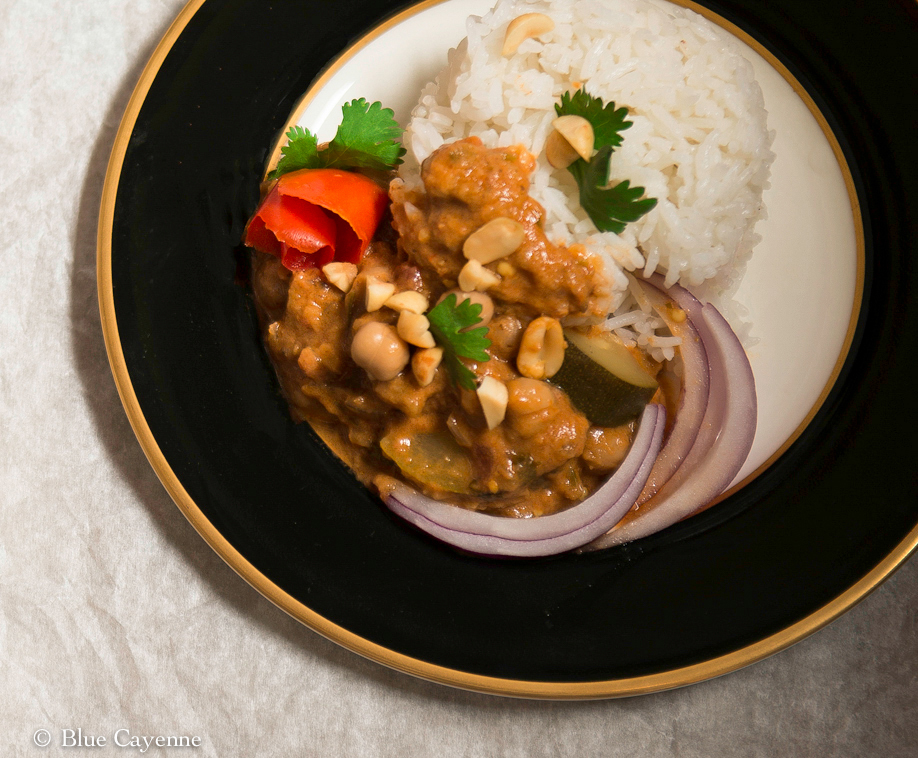This wonderful Julia Moskin recipe for Spicy Peanut Stew with Ginger and Tomato recently came across my desk and flooded my world with all kinds of happy memories. Talk about an endorphin rush!
When my husband and I were traveling, we were fortunate to make a number of trips to Africa. I have fond memories of interesting people we met, albeit briefly, on those trips: Mburu and Imani who kept us comfortable and safe when robbers invaded our safari camp; Shabir, our Pakistani driver, who drove like the wind in a VW van he called The Black Mambo; Alain Guichereau, the quirky French ex-pat tour guide, who eased us through tight situations with humor and more than a little bit of cheek; Brad Goodheart, a California science teacher and Wilderness Travel tour leader, who spent fall through spring in the classroom but when summer came rushed to anywhere that was wild. Travel is as much about the people you meet as about the sights you see. Along the way, you collect memories that stay with you forever.
Kenya was our first safari experience. The night we arrived in Nairobi it was just after midnight. We’d made a long flight from Los Angeles to Nairobi with layovers in New York and Amsterdam. To our weary delight, we were delayed for hours at the then bare-bones Jomo Kenyatta International Airport because there were lions sleeping on the road and the game wardens– sleeping in their homes–were slow to rise. After we did get into the city and catch a few hours of sleep, we hustled to our safari meet-up and, quickly, we were on the road heading for a safari adventure. To our amazement, we found wild creatures everywhere– elephants, zebras, wildebeests, dik-diks, lions, cheetahs, bongos, rhinos and on and on. I think my favorite creatures in Kenya were the sweet little dik-diks we saw in Samburu. Dik-diks are the tiniest of the antelopes, measuring just 12-16 inches at the shoulder. They usually weigh between 6 pounds and 16 pounds (just a bit larger than Juliet). They have large gorgeous eyes, live in pairs and mark their territory with their tears (really!). I haven’t been able to find a photo of one in my slides but here are two internet images I found. The second image is from the website of The Chester Zoo. I’ve also included a link to the zoo’s photo story about their interactions with the little orphaned dik-dik.
That first trip to Kenya opened many doors for us and birthed a wanderlust in us that, on each subsequent trip, lured us deeper and deeper into the continent–to Tanzania, Botswana, Rwanda, Zaire, Zambia, South Africa and Madagascar. As Louis Armstrong famously sang, “what a wonderful world!”
Our stays at safari lodges and in tented camps introduced us to new foods, too. Some of it was colonial. (Kenya was a British colony until 1963.) I enjoyed the best rice pudding in my life in the Masai Mara. And who even knew about Wheetabix as a morning cereal? (Check out Trader Joe’s. It is available there.) Then, there was the spectacular Indian food prepared by the Indian diaspora in a number of Kenyan cities. I decided that samosas must be the national snack of Kenya. It seemed that every city and roadside stop had a display–usually served warm with a fiery red chili sauce. But the most memorable foods were the safari “takes” on African cuisine–ugali (a polenta-like accompaniment to stews), irio (a boiled corn, potato and spinach/or pea dish), and any number of sweet potato and plaintain dishes.
African-inspired peanut stews like the one featured in this post were also a culinary mainstay on safari buffets.
Today, as I sat down to write this, I was surprised to find that I have three Kenyan cookbooks on my shelves. Damn. I was a foodie even then.
Hope you enjoy this dish.
Yields 8 Servings
1 hrTotal Time
Ingredients
- 1 medium-sized eggplant (peeled and cut into 1/2-inch dice)
- 1 t. salt (or to taste)
- 1 t. ground cumin
- 1 t. whole cumin seeds
- 1 t. ground coriander
- 1/4 t. turmeric
- 1/8 t. cayenne pepper
- 1/4 C. peanut oil
- 2 shallots (thinly-sliced)
- 2 inches fresh ginger (peeled and minced)
- 1-2 jalapeno chiles (seeded and minced)
- 1 onion (diced)
- 1/2 C. tomato paste
- 1 14.5 oz. can tomatoes (diced)
- 4 C. vegetable stock
- 1/2 C. natural unsweetened peanut butter (creamy or chunky--I used chunky)
- 1 medium zucchini cut in quarters lengthwise and then sliced 1/2-inch thick
- 1 15 oz. can garbanzo beans (drained and rinsed)
- 2 T freshly-squeezed lemon juice
- 1/3 C. coarsely chopped cilantro
- Cooked basmati or jasmine rice
- Garnishes: Chopped red onion, chopped avocado, chopped cilantro, chopped peanuts (your choice!)
Instructions
- Prepare eggplant. Place in a colander and toss with salt. Leave eggplant to drain for 30 minutes. Rinse and set aside.
- Combine ground and whole cumin, ground coriander, turmeric and cayenne pepper in a small bowl. Set aside.
- Put 3 T. oil in a large Dutch oven and heat it over medium-high heat. Fry the shallots in the hot oil. You will need to stir the shallots often to keep them from burning. You do want the shallots to be crisp and caramelized when you have finished cooking them. This took about 5 minutes. Remove the shallots from the oil using a slotted spoon. Put shallots in a large bowl. Set aside. Using the same Dutch oven, turn your heat to medium high and stir in the eggplant. You don't want to burn the eggplant. You do want it to get nicely browned and to be tender-cooked. This step will take about 5 minutes. Put the cooked eggplant in the bowl with the shallots. Set aside.
- Add the remaining oil to the pot that you used to cook the eggplant and, over medium to medium high heat, stir in the ginger and the chiles.This is a quick step. Sauté the ginger and chiles for about 30 seconds. Add the spices and stir. Add the onion and continue to cook until the onion becomes translucent and soft. This will take about 5 minutes. (As you stir, scrape the brown bits that have become fixed to the bottom of your pot.) Add the tomato paste and cook for 1 more minute.
- Add diced tomatoes, vegetable stock, eggplant/shallot mixture and a pinch of salt to the pot. Bring this mixture to a boil (then lower heat to medium) and cook for about 5 minutes.
- Meanwhile, put the peanut butter in a small bowl and stir some of the hot stock into the peanut butter until the mixture is emulsified. Once this is done, pour the peanut butter mixture back into the stew.
- Turn your heat down to a simmer and add zucchini and garbanzo beans to the stew. Cook covered for 10-15 minutes. You want the vegetables to be tender. Turn off the heat and stir in lemon juice and chopped cilantro. Taste for seasoning.
- Serve with white rice and condiments of your choice. I enjoyed chopped red onion, chunks of avocado and a sprinkling of peanuts.
Notes
This is another one of those dishes that improves greatly when allowed to sit in your refrigerator for a day. The extra time allows the flavors to mature.
Here is the link to the original recipe from which this recipe was adapted: Julia Moskin’s Spicy Peanut Stew with Ginger and Tomato



 Save Recipe
Save Recipe
1 thought on “Peanut Stew with Ginger and Tomato”